Sprayer set-up - The Art of Application
Winter disease attacks can have devastating effects that will last right through to next spring and summer - resulting in lower player satisfaction and increased costs of renovation, explains Syngenta Business Manager, Daniel Lightfoot
An effective Integrated Turf Management programme can minimise the potential damage, coupled to a proactive fungicide programme to see turf safely through risk periods. But, to get the best results, attention to the 'Art of Application' can make a significant difference.
Check your sprayer first
Accurate application starts with correct sprayer set-up. All sprayers should be maintained and inspected to the National Sprayer Testing Scheme (NSTS) standard - from November this year it will be a legal requirement. Furthermore, regular in-season inspection - including tyre pressure, hose condition, pressure regulation and nozzle condition etc. - could prevent problems or delays during applications.
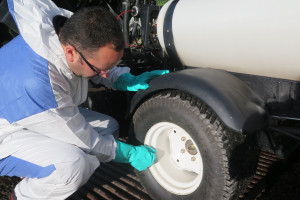 |
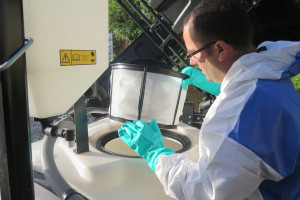 |
| Tyres are built in shock-absorbers. Make sure they are even, and typically run at the lowest a pressure recommended for the weight | Keeping the sprayer washed and clean - inside and out - makes it easier to check for potential problems |
Calibrate and calculate
Many operators are not comfortable or confident with sprayer calibration, but it should be a routine and simple process.
There's a video to help you with sprayer calibration set-up and information on all the calculations required on the GreenCast website, or using the free Syngenta Turf App for smartphones.
The two-step process should look to check the spray nozzle output for any given speed and operating pressure, and to check consistent nozzle output across the spray boom.
Always check calibration using a measuring cylinder, not a measuring jug - you need to be accurate.
If any individual nozzle is showing a +/- 5% difference from the average, attributed to wear, the whole set should be replaced.
As a useful guide, you can check the accuracy of your forward speed during spraying using one of the GPS apps available for smartphones.
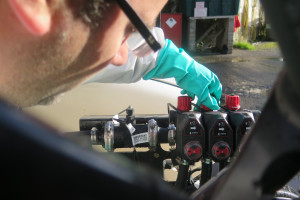 |
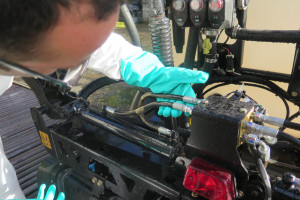 |
| Ensure the sprayer is correctly set-up for even pressure and consistent application across the boom | Check for any signs of oil leakage around hydraulic hoses and joints |
Set the right height
Most nozzles are designed to work best at a height of 50cm from the target - with limited flexibility. Too low and the spray pattern uniformity can be affected - typically seen as stripes following fertiliser or iron application; too high and spray drift quickly becomes a serious problem.
The Syngenta XC Nozzle also works best at 50cm, but is designed to give far greater flexibility. It will still deliver a consistently even spray pattern as low as 30cm, and far advanced spray drift control if the boom height rises. This is particularly important on undulating golf courses.
Easy to fit 'Spray Nozzle Height Indicators' give you a constant visual check on the boom height.
Remember, always measure from the target to nozzle tip, not the actual boom; on some amenity sprayers, that could be 10cm or more different.
Spraying winter greens is usually a consistent height, but remember for autumn applications of Rescue in rough, for example, the target grass leaves may be higher and the sprayer should be adjusted accordingly.
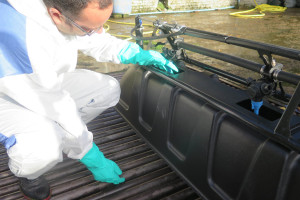 |
 |
| Check spray line hoses for signs of abrasion, especially where booms fold, for example | Set the boom height for nozzle tip to spray target at 50cm - remember to always measure from the nozzle tip, not the boom |
Get the right angle
Conventional flat fan nozzles tend to coat one side of a leaf with significantly more spray than the other; for winter contact fungicides, that could mean areas of leaf left unprotected. XC Nozzles are designed to deliver the spray pattern at an angle, set to compensate for the forward movement of the sprayer, to achieve better all-round coverage of a vertical leaf surfaces.
These nozzles should be inserted into international standard sprayer bayonets*, fitted onto the boom with the 'Syngenta' facing forwards - so the spray pattern is delivered rearwards.
*If you have a Hardi sprayer, a readily-available converter will be required to enable any industry standard nozzles - including XC Nozzles - to be used.
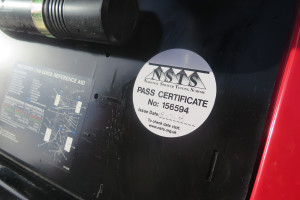 |
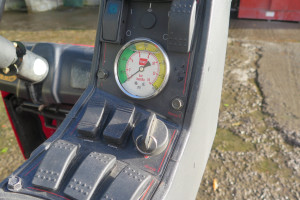 |
| New legislation means all mechanical sprayers require regular NSTS testing - but is good practice to avoid costly errors | Ensure all gauges are easy to read and mechanical switches are kept clean of dust or dirt |
Select the right nozzle size
Part of the nozzle calibration process will include selecting the right size nozzle for the water volume required. Understanding the activity of the fungicide treatment being used can help fine-tune water volume requirements.
For purely contact winter fungicides, it is essential to get good coverage and retention on the leaf. High water volumes or large droplet sizes have the risk of overwetting the leaf and rolling off. Reduced water volumes and the XC Nozzle spray pattern can increase the retention of spray on the leaf surface - and when you are spraying greens cut at 4mm height, there is precious little target!
With the Contact+ Medallion TL, however, there is the further benefit of activity on disease spores in the thatch, so nothing is wasted if there is some movement of spray down the leaf.
If you are using a highly systemic fungicide with root uptake, whilst turf is still growing actively in the autumn, for example, then leaf coverage is less important as the fungicide will move around the plant to target disease ingress. Furthermore, the active will be picked up by the root and transported through the growing leaf to give prolonged protection.
In practice, for most greens' applications, an 025 nozzle gives the appropriate balance of water volume, operating pressure and speed. For larger areas, sprayed at higher speed, the 04 may be more applicable to achieve desired work rates. And for high water volume applications, where the intention is to get more spray down to the roots, an 08 nozzle could be used.
The Greencast website and the turf app has output charts for all the XC Nozzle range, to help select the most appropriate settings.
 |
 |
| A clean water supply for emergency eye or hand wash is great - but it must be filled each time | Checking nozzles for wear and even output for accurate calibration should be a routine practice and will quickly pick up problems |
Know your area
Accurate knowledge of the area to be sprayed is vital to calculate the amount of product and water volume required. If you are only selectively treating a few susceptible greens, for example, the individual areas must be known.
Commercial course surveying and mapping services are available, or they can be simply manually calculated with handheld GPS devices.
Alternatively, areas can be calculated from Google Earth images and free internet mapping software.
If you redesign or alter greens areas over the winter, don't forget to adjust the spray records.
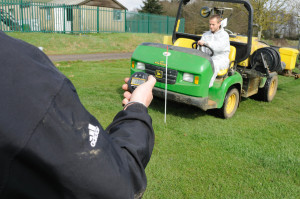 |
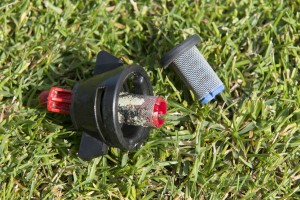 |
| Accurate calibration includes checking the speed of the sprayer and knowing precisely the size of the area being sprayed | Regularly check nozzle filters for any blockage or build-up of residues, especially with fertilisers or trace elements. Wash nozzles after use and fit filters appropriate to the sizer of nozzle orifice |
Assess risk and opportunity for application timing
Application timing is crucial to prevent damaging disease attacks and best protect turf quality - especially over the winter, when the effects of scars can last months before turf can be renovated and recover.
Local knowledge of disease incidence, the inspection of susceptible indicator greens and disease forecasting on the website can all help to optimise application timing, before the damage is done. In most instances, the aim is to treat as close as possible before infection occurs, to give the maximum protection through risk periods.
All fungicides work most effectively applied for proactive protection, before the symptoms of disease have caused damage and stress to turf plants. But, if some visible disease has occurred, some options, such as Instrata, do give greater kick-back activity to stop further development within the plant, as well as preventing new infection breaking out.
As well as assessing the risk of disease, you also need to balance the opportunities to spray. If you can foresee disease risk in a few days, or you have a tournament that demands the highest quality, but the weather forecast warns you won't be able to spray, earlier application may be timely.
The website combines diseases risk warnings, with spray window opportunities, to help best time your applications.
Furthermore, using low drift XC Nozzles ensures there is more available spray days and times for treatment, typically three to four more days a month compared to conventional flat fan nozzles.
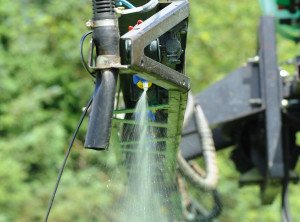 |
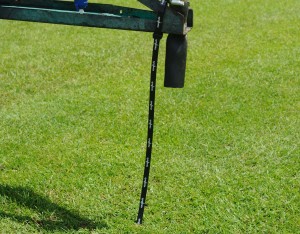 |
| New nozzle technology has brought benefits with improved coverage, greater flexibility and notably reduced drift | Fit a boom height indicator to quickly and easily check booms are operating at the desired height. |
Fill the sprayer carefully
It goes without saying that any spillages of concentrated chemicals are wasteful and, potentially, environmentally damaging. There are a few useful gadgets that could help minimise the risk. A metal sink and draining board mounted on a firm frame gives a stable platform to accurately measure chemicals into a jug; if you put a clean bucket under the sink plug hole, spillages can be washed down and added into the sprayer with no waste.
Be careful not to drop any pesticide container foil seals, which can contain traces of concentrate as point sources of contamination; the Syngenta S-Pac has been specifically designed to eliminate foils, to make them faster and safer to use.
Sprayers should always be filled in a designated area, where any spillage can be safely contained. It is worth having a simple spillage kit on the sprayer, containing a bag of sawdust or highly absorbent cat litter to mop up any spills, along with a designated dustpan and brush and plastic bags that can be labelled and disposed of appropriately.
Also, don't overfill the sprayer and risk spillage. Check around the induction hopper for any air leaks, since that can be the prime cause of foaming during the filling process. Be aware of poorly formulated products that can foam during filling and flow over.
Fitting a flow meter on the water inlet hose is an extremely accurate way to know precisely how much is in the tank, compared to a sight gauge. You can also get auto cut-off meters, so there is no risk of over-filling if you get distracted.
You can use the free Greencast Turf App to calculate tank mix requirements and other application advice, as well as recording and reporting all your actions in one convenient and simple operation.
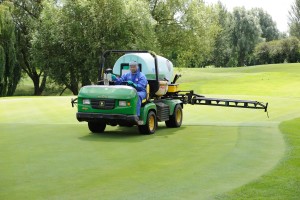 |
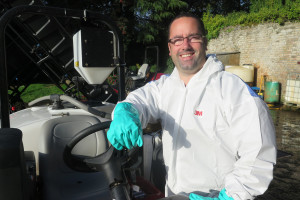 |
| When sprayers are well set-up and expertly operated the results will be consistently better for turf quality and environmental protection | Syngenta Business Manager, Daniel Lightfoot |
Clean out
If your calculations have been correct, and your application accurate, there should be little or no mix in the sprayer as you finish. Ideally, you would finish the last green at a slightly reduced application rate, wash out the sprayer and spray the rinsings back onto the final green to make up the full dose rate. Alternatively, spray the rinsings onto an untreated area.
Wash-off the outside of the sprayer on a designated area where, , water can be collected and processed, or a designated grass area where there is no risk of drainage into water courses.
Containers should be triple washed to clean out fully, ideally before you have finished working, so the contents can be added into the spray mix. A rinsing head in the sprayer induction hopper can be highly effective, but check all concentrate residues have been cleaned.
Record results
For a more effective Integrated Turf Management approach to disease control, it is important to record all your activities - such as mechanical operations, fertiliser inputs and topdressing, as well as spray inputs - and the presiding weather conditions. You can use the Syngenta Turf App to record all this with a paperless system in one place that is quick, concise and available for easy reference.
Over time, it will enable you to better understand when disease is likely to strike on your course, and what actions or applications can best minimise the risk and the effects in developing an effective sustainable strategy for the future.
